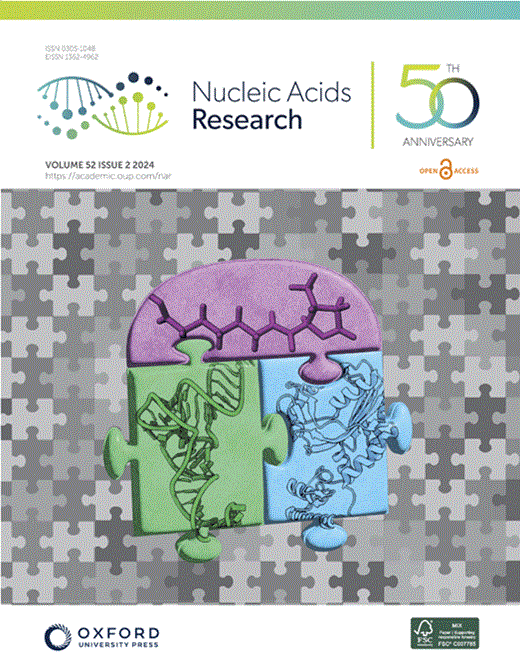CRISPR 基因敲除全基因组筛选确定了调节顺铂诱导的单链 DNA 缺口修复的 HELQ-RAD52 轴
IF 16.6
2区 生物学
Q1 BIOCHEMISTRY & MOLECULAR BIOLOGY
引用次数: 0
摘要
使用基因毒性药物(如铂化合物)进行治疗仍然是大多数癌症的主要治疗方法。然而,我们对这些药物作用机制的了解并不完善,而且还在不断发展。最近的研究进展突出表明,单链 DNA(ssDNA)间隙积累是顺铂化学敏感性的潜在决定因素,至少在某些遗传背景下是如此,如 BRCA 基因突变。顺铂诱导的 ssDNA 间隙是在 PRIMPOL 酶催化下重新启动顺铂诱导的病变下游 DNA 合成时形成的。在这里,我们发现 PRIMPOL 在野生型细胞中的过表达会导致顺铂诱导的 ssDNA 间隙积累,但不会使细胞对顺铂敏感,这表明 ssDNA 间隙积累不会使 BRCA 基因缺陷细胞对顺铂敏感。为了了解ssDNA间隙是如何导致细胞敏感性的,我们采用了CRISPR介导的全基因组遗传筛选,以确定能使顺铂诱导的ssDNA间隙产生细胞毒性的因素。我们发现,在PRIMPOL过表达的细胞中,螺旋酶HELQ特异性地抑制了顺铂的敏感性,这与ssDNA积累的减少有关。此外,我们还发现 RAD52 是这一途径的媒介。RAD52 通过 BRCA 介导的机制促进 ssDNA 间隙积累。我们的研究发现,HELQ-RAD52-BRCA轴是ssDNA间隙处理和顺铂敏感性的调节因子。本文章由计算机程序翻译,如有差异,请以英文原文为准。
CRISPR knockout genome-wide screens identify the HELQ-RAD52 axis in regulating the repair of cisplatin-induced single-stranded DNA gaps
Treatment with genotoxic agents, such as platinum compounds, is still the mainstay therapeutical approach for the majority of cancers. Our understanding of the mechanisms of action of these drugs is, however, imperfect and continuously evolving. Recent advances highlighted single-stranded DNA (ssDNA) gap accumulation as a potential determinant underlying cisplatin chemosensitivity, at least in some genetic backgrounds, such as BRCA mutations. Cisplatin-induced ssDNA gaps form upon restart of DNA synthesis downstream of cisplatin-induced lesions through repriming catalyzed by the PRIMPOL enzyme. Here, we show that PRIMPOL overexpression in otherwise wild-type cells results in accumulation of cisplatin-induced ssDNA gaps without sensitizing cells to cisplatin, suggesting that ssDNA gap accumulation does not confer cisplatin sensitivity in BRCA-proficient cells. To understand how ssDNA gaps may cause cellular sensitivity, we employed CRISPR-mediated genome-wide genetic screening to identify factors which enable the cytotoxicity of cisplatin-induced ssDNA gaps. We found that the helicase HELQ specifically suppresses cisplatin sensitivity in PRIMPOL-overexpressing cells, and this is associated with reduced ssDNA accumulation. We moreover identify RAD52 as a mediator of this pathway. RAD52 promotes ssDNA gap accumulation through a BRCA-mediated mechanism. Our work identified the HELQ-RAD52-BRCA axis as a regulator of ssDNA gap processing and cisplatin sensitization.
求助全文
通过发布文献求助,成功后即可免费获取论文全文。
去求助
来源期刊

Nucleic Acids Research
生物-生化与分子生物学
CiteScore
27.10
自引率
4.70%
发文量
1057
审稿时长
2 months
期刊介绍:
Nucleic Acids Research (NAR) is a scientific journal that publishes research on various aspects of nucleic acids and proteins involved in nucleic acid metabolism and interactions. It covers areas such as chemistry and synthetic biology, computational biology, gene regulation, chromatin and epigenetics, genome integrity, repair and replication, genomics, molecular biology, nucleic acid enzymes, RNA, and structural biology. The journal also includes a Survey and Summary section for brief reviews. Additionally, each year, the first issue is dedicated to biological databases, and an issue in July focuses on web-based software resources for the biological community. Nucleic Acids Research is indexed by several services including Abstracts on Hygiene and Communicable Diseases, Animal Breeding Abstracts, Agricultural Engineering Abstracts, Agbiotech News and Information, BIOSIS Previews, CAB Abstracts, and EMBASE.
 求助内容:
求助内容: 应助结果提醒方式:
应助结果提醒方式:


